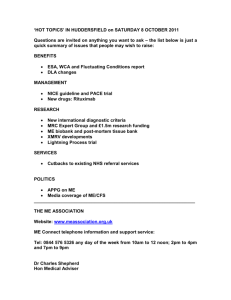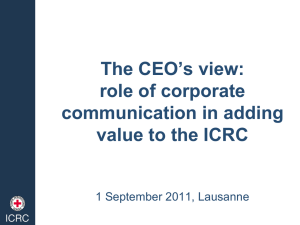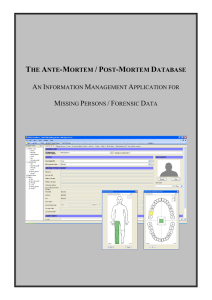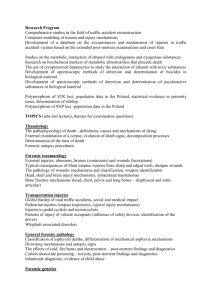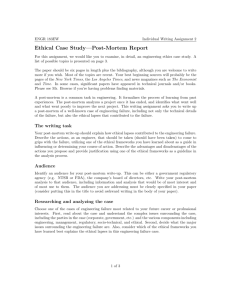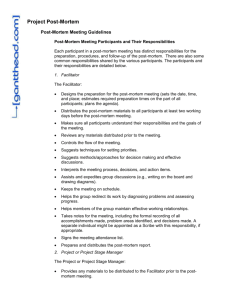ante-mortem:post-mortem database - International Committee of the
advertisement
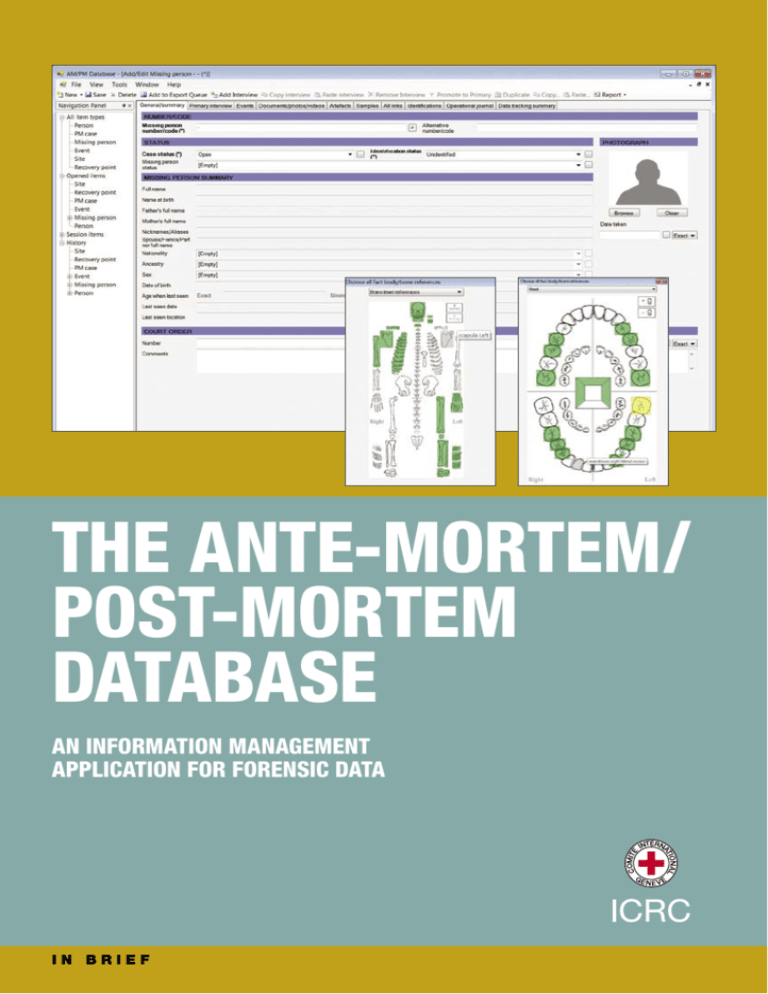
THE ANTE-MORTEM/ POST-MORTEM DATABASE AN INFORMATION MANAGEMENT APPLICATION FOR FORENSIC DATA IN BRIEF INTRODUCTION The International Committee of the Red Cross (ICRC) is a neutral, impartial and independent humanitarian organization that provides protection and assistance to victims of armed conflict and internal violence. It is mandated to do so by the community of nations, acting under the authority of the Geneva Conventions and their Additional Protocols. In war, following disasters, or as a result of migration or internal violence, people may go missing and human remains stay unidentified. When a missing person is believed to be dead, two complementary lines of investigation have to be opened: tracing that person’s whereabouts and scientific identification of human remains. Management of information plays a crucial role in bringing these two lines of investigation together in order to identify remains and resolve cases of disappearance. Standardization, centralization and easy exchange of large quantities of data among numerous parties are essential elements of an effective data management strategy. Electronic tools can make an extremely valuable contribution to this. Following the International Conference on the Missing and their Families, in 2003, the ICRC was asked to develop a forensic information management tool – a database – that could be used by others to compile, manage, centralize and process files on missing persons and unidentified remains effectively. In 2005, the ICRC – in consultation with a number of organizations and experts throughout the world – began work on the Ante-Mortem/ 2 Post-Mortem (AMPM) Database. It was made available for use in 2008. OBJECTIVES The AMPM Database is an electronic tool for managing information on missing persons and human remains, on the circumstances surrounding cases of disappearance, and on bodies (or body parts) that have been recovered (as well as the places where they were found). The Database is highly configurable for use in a large variety of contexts. It is delivered in English but is fully translatable. It can be used in singleor multi-user, server-based environments. The Database facilitates the identification process by suppor ting the archiving, standardization, repor ting, searching, and analysis of forensic data, as well as the automated basic matching of AM and PM data. It also provides and promotes best practices for data management and the use of appropriate methods. No data is delivered with the AMPM Database. At present, approximately 50 institutions are using it: among them, medico-legal institutes, government bodies in charge of resolving cases of missing persons (including national information bureaus), and non-governmental organizations. The AMPM Database is provided free of charge by the ICRC.1 1 For information on acquiring the AMPM Database, contact gva_op_ assist_forensic@icrc.org or your nearest ICRC office. MODULES Missing Persons (Ante-Mortem Data) includes all information on missing persons, such as personal, physical, medical and dental information, as well as information on the circumstances of their disappearance. Detailed DNA data for Missing Persons and Persons (family members) can be manually entered or electronically imported. More than one antemortem data interview per missing person can be entered and consolidated. Sites, Recovery Points and Deposits include all field data related to location and recovery of remains. These modules make it possible to register gravesites, document site assessment data, and record all exhumation/recovery/grave information. Detailed geographical reference data can be entered manually or imported electronically. Post-Mortem Cases (Human Remains) includes all information obtained during post-mortem examination, including detailed pathology, anthropology and odontology data, and information related to the cause of death. Detailed DNA data for Post-Mortem Cases can be manually entered or electronically imported. Commingled elements can be re-associated with other cases once positive associations have been determined. Estimation of minimum number of individuals for commingled elements is provided by the database. Anthropological methods and formulae for age, sex and stature are pre-loaded in the Database. All field data related to PostMortem Cases are linked directly to pertinent Sites, Recovery Points and Deposits. More than one examination for each post-mortem case can be entered and consolidated. 3 MODULES Events includes information on any event related to the group of missing persons and unidentified remains being searched, such as military battles in which soldiers went missing, mass burial events, or natural or man-made disasters. The Events module allows linking between several events and between events and main entities, such as Missing Persons, Sites or Post-Mortem Cases. Information obtained through Witness Statements can be recorded in Events and Sites. Information about related Missing Persons, PostMortem Cases and all pertinent actors can also be documented in the Witness Statements module. Witness Statements includes interviews with individuals, as well as all other sources of information, such as media articles or investigative documents. More than one witness statement per event or site can be entered and consolidated. The Identification module makes it possible to track hypotheses and confirmations of identity or exclusion, as arrived at through the matching of AM and PM data. Case Management makes it possible to track all actions taken in a certain case, as well as all chain of custody movements. Case Management entries are entered manually. 4 FUNCTIONALITIES/TOOLS The Matching Tool enables automated matching of AM and PM data for all or selected cases, based on pre-defined matching criteria. Results of potential matches are displayed, with a direct link to the Identification module, so that each user can compare potential matches to form hypotheses of identity or exclusion. The Query Builder makes it possible to do a detailed search of, and cross-reference, all information entered into the Database – based on user-defined criteria. Query results can be exported to Microsoft Excel and other formats for statistical analysis or for display in GIS. All main entities can be Searched, and searches can be filtered. Contacts and Persons Management make it possible to archive and cross-reference data on all the persons entered into the Database, such as family members and contacts of Missing Persons, investigators associated with cases that have been entered, or the Database’s dataentry staff. 5 FUNCTIONALITIES/TOOLS Document Management enables archiving and management of documents, photos, videos and any other files associated with entities entered into the Database. To prevent the Database from becoming excessively large, the documents in question are not stored there, but elsewhere; they are easily accessed through hyperlinks. Sample Management enables documentation of all samples associated with all entity types, such as soil, botanical and faunal samples collected during recovery, or detailed information on biological samples, including DNA information on Missing Persons, Persons and Post-Mortem Cases. Artefact Management makes it possible to document all artefacts and other evidence related to all entity types, such as clothing and personal effects associated with Missing Persons and Post-Mortem Cases, evidentiary items such as bullets, blindfolds and ligatures, or medical items such as eyeglasses, hearing aids and orthotics. Security Roles Management controls access for groups and for individual users. Individuals with restricted access will not be able to make modifications to the data (read-only); nor will they have access to sensitive personal data. 6 Language preferences can be set in Mission Configuration, along with date formatting, preferred dental coding system, and the anthropological formulae to be used in the Database. The Data Import and Export tools enable users of the Database to share data with one another. A password can be used for added security. Users can select one case at a time for sharing. All cases can also be exported into a single file for backup purposes. To enhance standardization, the Reference Data Manager permits modification of predelivered standard lists of reference data available in look-up tables. The Translation Manager enables access to all texts in the Database for easy translation into any two languages. 7 FUNCTIONALITIES/TOOLS Fields can be added, hidden, changed or translated through Configure Forms, to suit the needs of the user. Pre-formatted Reports are available for Missing Persons in both languages in which the Database operates. Users can create their own report templates with report-building software or by using the “mail merge” function in Microsoft Word based on query results. Future versions of the Database will include a predetermined format for reports on Post-Mortem Cases, as well as the ability to develop an unlimited number of user-formatted reports for all entities and query results for easy presentation of cross-entity data. 8 OTHER FEATURES RELATIONSHIP LINKS Makes it possible to set links between family members (Persons or Missing Persons) for easy tracking of all established and potential links between individuals and DNA samples. PM LINKS Permits potential links between Post-Mortem Cases to be recorded. IMPORT DNA DATA Enables DNA data to be imported electronically for easy entry and automated creation of associated Samples within Missing Persons and Post-Mortem Cases. IMPORT FROM TOTAL STATION Makes it possible to electronically import total station data for easy entry of field data and automated creation of associated Sites, Recovery Points, Deposits and Post-Mortem Cases. IMPORT METHODS Additional anthropological methods and formulae can be developed by the user and easily imported into the Database. DATA MIGRATION TOOL This is a separate tool that allows users to format data from other database software for import into the Database. BACKUP AND RESTORE TOOL This is a separate tool for easy backup and restoration of the SQL database. SENSITIVE DATA MANAGEMENT This permits the database administrator to set the sensitivity of Missing Persons data. APPLICATION CONFIGURATION This permits separate mission databases to be accessed through one user interface. SYNCHRONIZATION The Database can function in either a stand-alone or a client/server environment. In a client/server environment, workstations can be de-synchronized from the server and re-synchronized after data have been entered. BUSINESS KEY TEMPLATES This enables case numbers/codes to be set in accordance with a user-defined format. DELETE BUSINESS DATA This permits all the cases that have been entered to be deleted easily, without also deleting a configured installation of the Database. UNDELETION MANAGER This makes it possible to restore or retrieve cases that have been deleted accidentally. 9 FUTURE ENHANCEMENTS The incorporation of a DNA Matching Tool, to assist users in forming hypotheses of identity based on DNA data, is planned for 2013. An Audit Function, that provides more assistance for database administrators in tracking changes by data entry staff to cases already entered, is planned for 2013–2014. TECHNICAL SPECIFICATIONS • Recommended minimum system requirements – Windows XP SP2, Vista or Windows 7 For installation on a Mac, a virtual machine is required. The Database is not available on Linux. – RAM for 32-bit systems: 1 GB – RAM for 64-bit systems: 2 GB – Available disk space: 1 GB Linked files in the document repository are external to the AMPM Database and will require additional disk space. – Processor speed: 1.6 GHz (slower processors may result in slower response from the Database) • .NET • Packaging – MS SQL Server Express (1–5 simultaneous users, FREE) – MS SQL Server (6+ simultaneous users, MS licence required) • Crystal Reports/Microsoft Reporting Services • Query Export: SQL View, Excel, flat file • Anthropological Method Definition: xml 10 SUPPORT Technical support in English, French, Arabic and Spanish is available online and over the phone. For more information on the AMPM Database, contact the Forensic Services of the ICRC at gva_op_assist_forensic@icrc.org or your nearest ICRC office. NOTES 11 4155/002 12.2013 500 International Committee of the Red Cross 19, avenue de la Paix 1202 Geneva, Switzerland T +41 22 734 60 01 F +41 22 733 20 57 www.icrc.org © ICRC, December 2013
